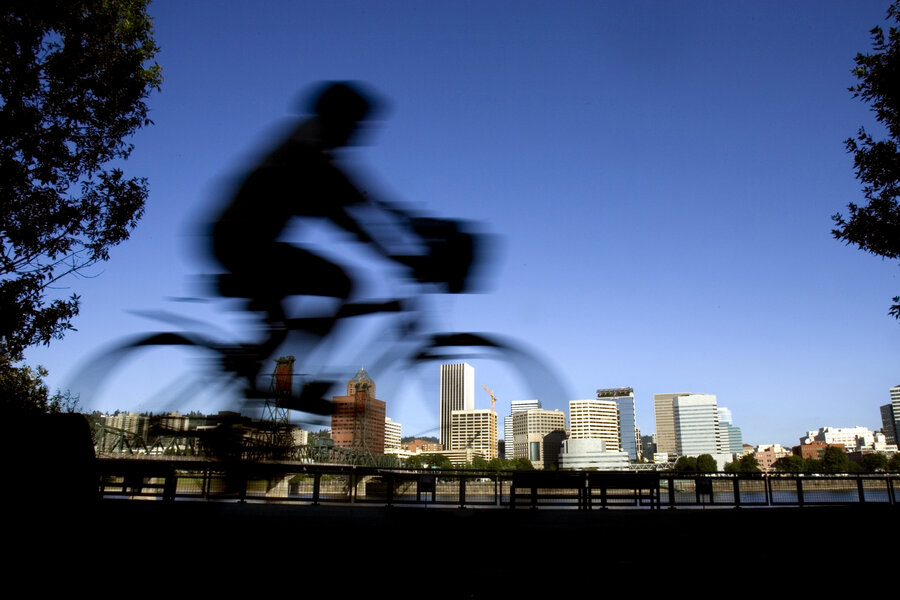New lights signal need for more bike lanes and education
Bicycle safety has progressed from a few reflectors and a bent elbow as a turn signal to new Bluetooth technology that allows your smartphone to turn the wheels into lighted indicators.
Cycling aficionados say that gadgets are great, but educating drivers, creating better bike lanes, and teaching people to be better bike handlers are the real road to nationwide cycling safety.
Revolights are a series of LED lights that attach directly to your wheels via forked magnet clips with technology that is constantly analyzing your speed in order to synchronize the lights with the tire revolution and thus create two crescents of light.
The latest iteration of these is the new Eclipse+ "snap-in" battery which can be paired with a Bluetooth enabled smartwatch or smartphone, according to its Indiegogo pitch where the makers have raised over $70,000 in 7 days.
With this new version, a cyclist can track rides and monitor battery life via smartphone. The arcs of light can be converted into turn signals by gesturing with a smartwatch, using a control pad on the handlebars or via app.
Kelley Howell, president of the advocacy group Bike Norfolk in Virginia where she has a day job working in technology and spends her spare time teaching bike safety classes as an instructor for the League of American Bicyclists, says in an interview, “My unconventional response to these lights is they’re a big waste of money.”
“From a bike safety perspective as an LCI (Licensed Cycling Instructor) by the time somebody sees that signal in the dark it’s kinda too late to help them out,” says Ms. Howell. “What most people really need is to take a class to learn to be a better, safer cyclist. Also, who can afford all that tech? A lot of people who ride bikes don’t have money. We have a campaign every December to give out just basic lights and people are so grateful just to have them.”
Luke Elrath, former product manager for Trek bicycles and now a cycling safety expert with Robson Forensic in Philadelphia, Pa., says in an email interview, “The manual turn signal is still the primary means for a cyclist to communicate their intentions to other road users. As technology advances, lighter, brighter, and longer-lasting lights are available in the market. Those riders who wish to be more visible in low-light situations have more and more choices. Additionally, there are countries that mandate passive lighting (front and rear lights powered by the rider’s pedaling) for all transportation-style bicycles. The rider never needs to think about dead batteries or stolen lights; everything is integrated into the bike’s design.”
According to Mr. Elrath, “The larger trend that this type of technology indicates is that of 'all conditions cycling.' Riders want to use their bicycles for recreation, transportation and utility in all weather, day and night, all seasons of the year. Developments in LED lighting and the falling cost for control circuitry are bringing devices like this within reach of more riders.”
Conditions are improving for some cycling enthusiasts.
“We’re nowhere close to being the Netherlands where biking is concerned, but Florida has done an awesome job. But they spend the money,” Howell says. “The state makes it all back in tourism, though. Here in Virginia and other states, we really have to work on generating the political will on this.”
Howell also points to Portland, Oregon, which put $600 million of city funds into revamping bicycle lanes.
Elrath adds, “Education for all road users is critical. Motor vehicle operators should understand that bicyclists are road users. Bicycle riders need to be taught the right way to ride in traffic from an early age. Safe riding can be integrated into school curricula, as it is in many European countries with high ridership. This needs to happen in parallel with all efforts to improve cycling infrastructure like bike lanes and bike paths.”
Another issue for cyclists, Howell says, is the commitment of cities to make sure they clean the bike lanes they do have.
“I often say I could build a house out of all the stuff I find in the bike lanes – roofing nails, boards, singles,” Howell says. “That’s why relegating cyclists to a bike lane made out of a converted gutter or shoulder is a bad idea because everything on the roads just naturally is swept into those areas by passing cars.”
Elrath concludes, “People are looking for alternative ways to carry out short trips without a car, and the bicycle is an inexpensive, non-polluting way to achieve that. Physically separated bicycle facilities are one development gaining popularity in some areas. Bike lane mileage grows every year in the United States.”







